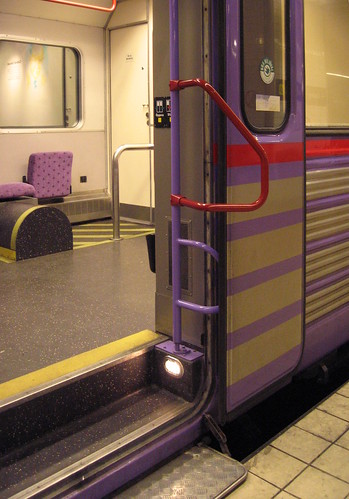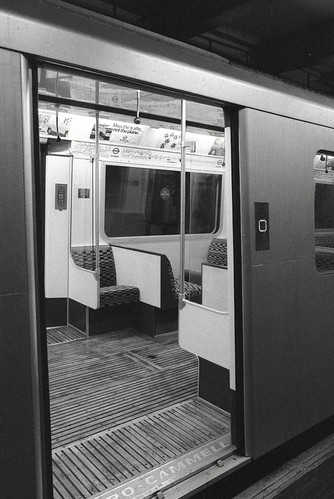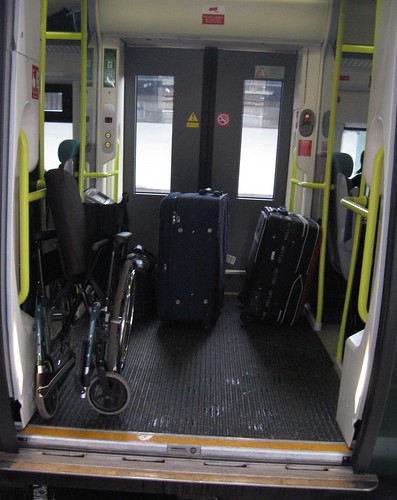
This is an example of the Swedish X11 suburban train. It has swing-plug doors with handles which rotate out over the gap between platform and train, and a drop-down step which covers the gap. These are desirable features for all new trains, not just for safety, but because they promote faster boarding and alighting, thereby reducing station dwell times. Although there is a big variation in station platform heights, getting on and off trains in Sweden is usually quite easy especially with newer stock.

Above we see the doorway of London Underground's District Line D78 stock. These have never been considered successful. These have four single-leaf doorways instead of the traditional two-doubles and two singles at each end. It was thought that the provision of good stand-back space on either side of the doors would have sufficed to promote a good flow of people at stations but in practice these proved inadequate. A similar single-leaf door configuration was adopted for the 1983 Jubilee Line stock and was even less satisfactory on tube services, so much so that the stock was withdrawn after only 15 years in service. However, this configuration might well have been more effective than the two pairs of bi-parting doors which has been standard for most suburban stock in the UK since the mid-1970s.
These particular trains can present difficulties for people with impaired mobility due to the absence of handrails on either side of the door, which is potentially hazardous at stations with curved platforms where there is a wide gap, and where there is a large difference between platform and floor height - this can be up to 40 cm.

Another type of train which has a bad reputation for excessive station dwell times is the class 158, above, with end doors about 800 mm wide. This led to the adoption of the 1:3/2:3 double-doors configuration of their successors, the Turbostar and Electrostar family of designs. This could, however, have been a mistake. There are two features of the class 158 doorway which would impede movement on and off the train. The first is the awkward step (below), less than 150 mm from nose to riser. The second is the presence of pinch points immediately inside the entrance vestibules. With a better-designed step, possibly associated with the use of simple sliding doors, and good internal circulation space, this end-door configuration might not be significantly worse that the 1:3/2:3 layout, with advantages which will be discussed later.

An awkward step is also a feature of other trains fitted with plug doors such as the Electostar, below. At first sight this is needed to provide a closing lip for the door but such a feature is not found on trains such as the Voyager and Meridian classes, where the step board is entirely inside the vehicle. There is no obvious reason for the pronounced lower bodyside curvature, especially since the stepboard then forms a projection. This curvature also reduces width at floor level, a problem compounded when a skirting level duct is provided. According to information provided by a then Railtrack gauging engineer, there is no reason why trains cannot have straight-down sides below the windows down to 1225 above rail level. But in any case the need for a closing lip does not explain the need for the change of level in the doorways of the class 376 Electrostars with conventional pocketed sliding doors.


The 1:3/2:3 door configuration has now become ubiquitous. As can be seen, it leads to bunching on station platforms, though less so than with vehicles with end-door configuration. Earlier designs such as class 455 had doorways giving just 1.2 metres clear opening. Electrostars have wider doorways but standback space is minimal and the full width of the doorway opening is rarely used or even available for use, especially at busy periods, due to standing passengers getting in the way. Consequently passengers tend to board and alight in single file. In so far as these trains can be loaded and unloaded faster than end door stock such as class 158, the difference may be due as much to the better circulation space inside the vehicles than the position of the doors as such. But there is no opportunity for genuine like-for-like comparison. Despite the poor experience with the London Underground D78 stock, it may be that three or four narrower doors per vehicle give better performance than two wider ones. This is an area where research needs to be done.
Conclusion
The entrance arrangements on trains need to be the subject of further research. The location of the doors is not optimal, nor is the detail design of the doorways themselves, especially in regard to the step detail and handrail position. There is a need to move towards a specification that provides the facilities illustrated in the Swedish train at the top of this article.
Inga kommentarer:
Skicka en kommentar